Related Research Articles

The Judgement of Paris is a story from Greek mythology, which was one of the events that led up to the Trojan War and in later versions of the story to the foundation of Rome.

The Latin alphabet, also known as the Roman alphabet, is the collection of letters originally used by the ancient Romans to write the Latin language. Largely unaltered with the exception of extensions, it forms the Latin script that is used to write many modern European languages, including English. With modifications, it is also used for other alphabets, such as the Vietnamese alphabet. Its modern repertoire is standardised as the ISO basic Latin alphabet.

Sappho was an Archaic Greek poet from Eresos or Mytilene on the island of Lesbos. Sappho is known for her lyric poetry, written to be sung while accompanied by music. In ancient times, Sappho was widely regarded as one of the greatest lyric poets and was given names such as the "Tenth Muse" and "The Poetess". Most of Sappho's poetry is now lost, and what is extant has mostly survived in fragmentary form; only the "Ode to Aphrodite" is certainly complete. As well as lyric poetry, ancient commentators claimed that Sappho wrote elegiac and iambic poetry. Three epigrams attributed to Sappho are extant, but these are actually Hellenistic imitations of Sappho's style.
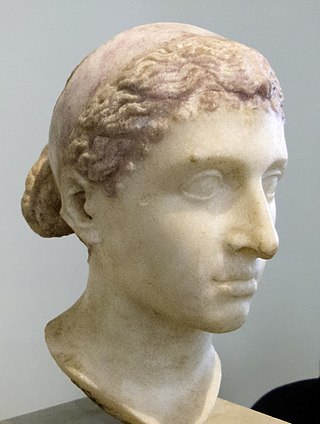
Cleopatra VII Thea Philopator was Queen of the Ptolemaic Kingdom of Egypt from 51 to 30 BC, and its last active ruler. A member of the Ptolemaic dynasty, she was a descendant of its founder Ptolemy I Soter, a Macedonian Greek general and companion of Alexander the Great. After the death of Cleopatra, Egypt became a province of the Roman Empire, marking the end of the last Hellenistic period state in the Mediterranean and of the age that had lasted since the reign of Alexander. Although her first language was Koine Greek, she was the only Ptolemaic ruler to learn and use the Egyptian language.
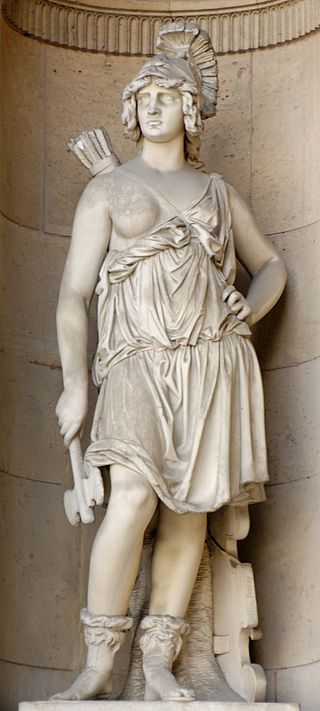
Penthesilea was an Amazonian queen in Greek mythology, the daughter of Ares and Otrera and the sister of Hippolyta, Antiope and Melanippe. She assisted Troy in the Trojan War, during which she was killed by Achilles. The asteroid 271 Penthesilea, discovered in 1887, was named in her honor.
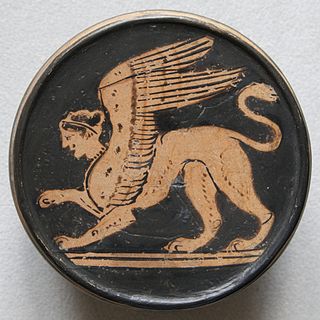
A sphinx is a mythical creature with the head of a human, the body of a lion, and the wings of an eagle.

In ancient Roman religion, Roma was a female deity who personified the city of Rome and more broadly, the Roman state. She was created and promoted to represent and propagate certain of Rome's ideas about itself, and to justify its rule. She was portrayed on coins, sculptures, architectural designs, and at official games and festivals. Images of Roma had elements in common with other goddesses, such as Rome's Minerva, her Greek equivalent Athena and various manifestations of Greek Tyches, who protected Greek city-states; among these, Roma stands dominant, over piled weapons that represent her conquests, and promising protection to the obedient. Her "Amazonian" iconography shows her "manly virtue" (virtus) as fierce mother of a warrior race, augmenting rather than replacing local goddesses. On some coinage of the Roman Imperial era, she is shown as a serene advisor, partner and protector of ruling emperors. In Rome, the Emperor Hadrian built and dedicated a gigantic temple to her as Roma Aeterna, and to Venus Felix,, emphasising the sacred, universal and eternal nature of the empire.

Aspasia was a metic woman in Classical Athens. Born in Miletus, she moved to Athens and began a relationship with the statesman Pericles, with whom she had a son, Pericles the Younger. According to the traditional historical narrative, she worked as a courtesan and was tried for asebeia (impiety), though modern scholars have questioned the factual basis for either of these claims, which both derive from ancient comedy. Though Aspasia is one of the best-attested women from the Greco-Roman world, and the most important woman in the history of fifth-century Athens, almost nothing is certain about her life.
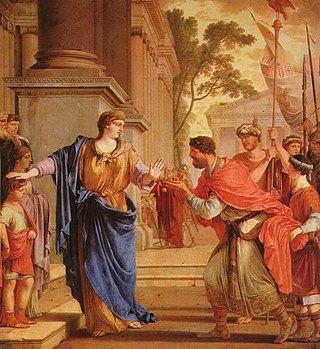
Cornelia was the second daughter of Publius Cornelius Scipio Africanus, a Roman general prominent in the Second Punic War, and Aemilia Paulla. Although drawing similarities to prototypical examples of virtuous Roman women, such as Lucretia, Cornelia puts herself apart from the rest because of her interest in literature, writing, and her investment in the political careers of her sons. She was the mother of the Gracchi brothers, and the mother-in-law of Scipio Aemilianus.
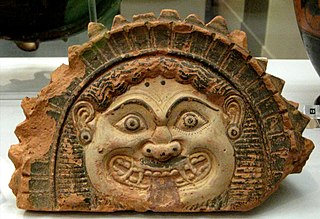
In Greek mythology, Medusa, also called Gorgo, was one of the three monstrous Gorgons, generally described as winged human females with living venomous snakes in place of hair. Those who gazed into her eyes would turn to stone. Most sources describe her as the daughter of Phorcys and Ceto, although the author Hyginus makes her the daughter of Gorgon and Ceto.
Aesara of Lucania was a Pythagorean philosopher who wrote On Human Nature, of which a fragment is preserved by Stobaeus.
Theano was a 6th-century BC Pythagorean philosopher. She has been called the wife or student of Pythagoras, although others see her as the wife of Brontinus. Her place of birth and the identity of her father is uncertain as well. Many Pythagorean writings were attributed to her in antiquity, including some letters and a few fragments from philosophical treatises, although these are all regarded as spurious by modern scholars.
The Pella curse tablet is a text written in a distinct Doric Greek idiom, found in Pella, the ancient capital of Macedon, in 1986. Ιt contains a curse or magic spell inscribed on a lead scroll, dated to the first half of the 4th century BC. It was published in the Hellenic Dialectology Journal in 1993. It is one of four known texts that may represent a local dialectal form of ancient Greek in Macedonia, all of them identifiable as Doric. These suggest that a Doric Greek dialect was spoken in Macedonia, as was previously proposed based on the West Greek forms of names found in Macedonia. As a result, the Pella curse tablet has been forwarded as an argument that the Ancient Macedonian language was a dialect of North-Western Greek, and one of the Doric dialects.

Arete of Cyrene was a Cyrenaic philosopher who lived in Cyrene, Libya. She was the daughter of Aristippus of Cyrene.

Proverbs 31 is the 31st and final chapter of the Book of Proverbs in the Hebrew Bible or the Old Testament of the Christian Bible. Verses 1 to 9 present the advice which King Lemuel's mother gave to him, about how a just king should reign. The remaining verses detail the attributes of a good wife or an ideal woman. The latter section is also known as Eshet Ḥayil.
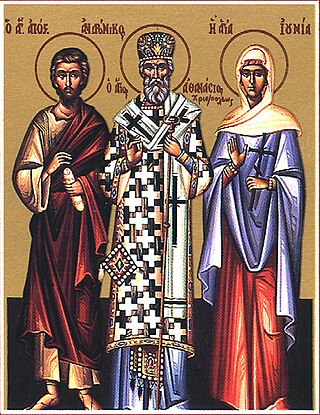
Junia or Junias was a Christian in the first century known from Paul the Apostle's letter to the Romans.
Perictione was the mother of the Greek philosopher Plato.

Stateira, possibly also known as Homa, was the daughter of Stateira and Darius III of Persia. After her father's defeat at the Battle of Issus, Stateira and her sisters became captives of Alexander of Macedon. They were treated well, and she became Alexander's second wife at the Susa weddings in 324 BC. At the same ceremony Alexander also married her cousin, Parysatis, daughter of Darius' predecessor. After Alexander's death in 323 BC, Stateira was killed by Alexander's other wife, Roxana.
Myia was a Pythagorean philosopher and, according to later tradition, one of the daughters of Theano and Pythagoras.

The Cumaean Sibyl was the priestess presiding over the Apollonian oracle at Cumae, a Greek colony near Naples, Italy. The word sibyl comes from the ancient Greek word sibylla, meaning prophetess. There were many sibyls throughout the ancient world. Because of the importance of the Cumaean Sibyl in the legends of early Rome as codified in Virgil's Aeneid VI, and because of her proximity to Rome, the Cumaean Sibyl became the most famous among the Romans. The Erythraean Sibyl from modern-day Turkey was famed among Greeks, as was the oldest Hellenic oracle, the Sibyl of Dodona, dating to the second millennium BC according to Herodotus, favored in the east.
References
- 1 2 Prudence Allen (22 May 1997). The concept of woman: the Aristotelian revolution, 750 BC–AD 1250. p. 150. ISBN 9780802842701.
- 1 2 3 4 Ian Plant (2004). Women Writers of Ancient Greece and Rome: An Anthology. Equinox. p. 83. ISBN 1904768024.